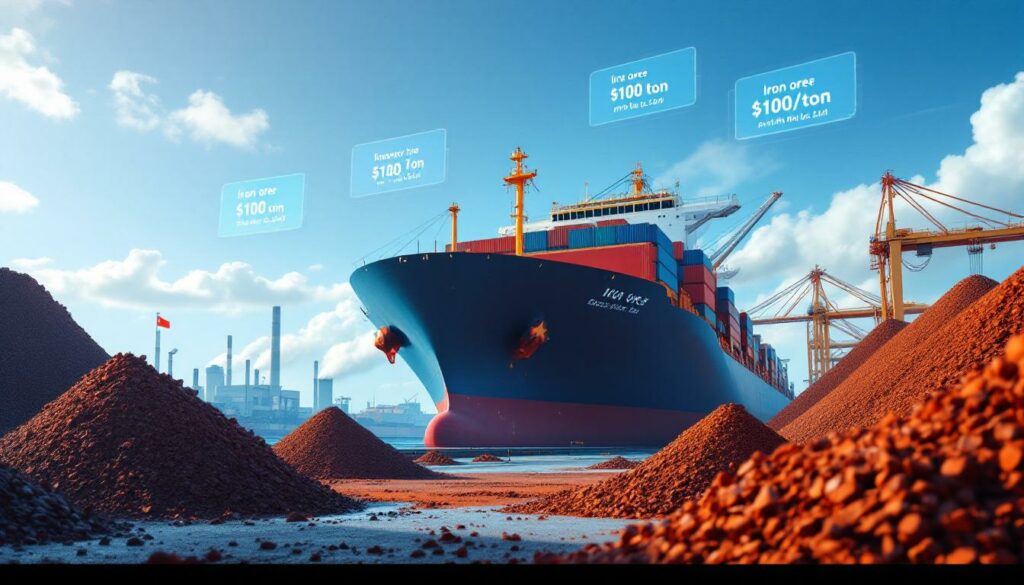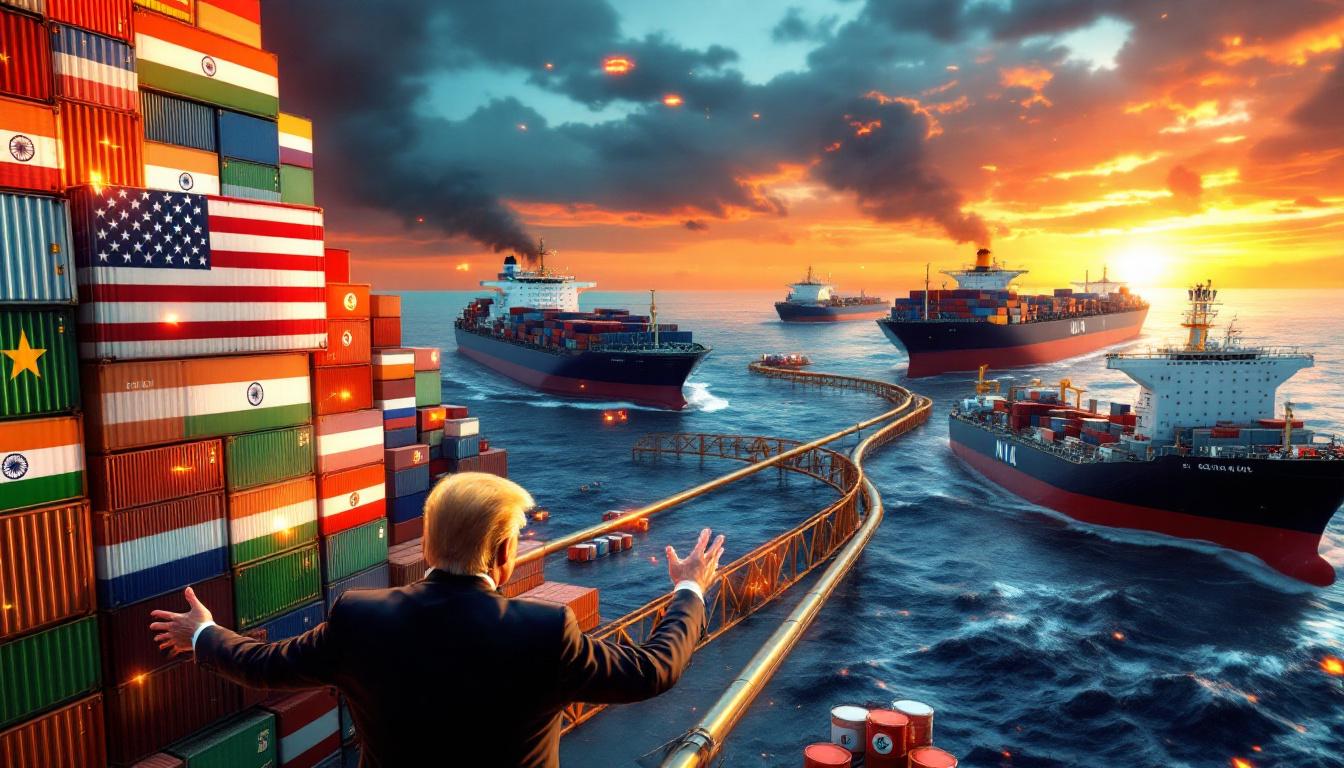Understanding China's Iron Ore Imports: Market Stability Amid Economic Headwinds
China's iron ore market has demonstrated remarkable resilience throughout 2025, maintaining stability despite significant economic challenges in the broader steel sector. As the dominant global consumer accounting for approximately 75% of seaborne iron ore trade, China's iron ore price trends serve as the primary barometer for global market health.
The first half of 2025 saw China iron ore imports reach 592.2 million tons, representing a modest 3% decline compared to the same period in 2024. This relatively small reduction comes despite more significant contractions in domestic steel production, highlighting the complex dynamics at play in China's resource strategy.
June 2025 proved particularly strong, with arrivals reaching 105.95 million tons—the highest monthly figure since December 2024. This robust performance continued into July, with preliminary estimates from commodity analytics firm Kpler indicating imports of approximately 101.32 million tons.
Import Trends Analysis
The stability in iron ore imports contrasts sharply with the challenges facing China's steel sector, suggesting strategic considerations beyond immediate production needs. Port inventories remain relatively low by historical standards, potentially indicating a long-term stockpiling strategy aimed at resource security.
Maritime tracking data reveals that Australia's industry leadership continues to dominate as China's primary iron ore supplier, accounting for approximately 65% of total imports in 2025. Brazilian shipments have shown steady growth, reaching their highest market share since 2018, while newer suppliers from West Africa have gained modest but growing positions in the supply chain.
"The relative resilience of China's iron ore imports appears to be the main reason that prices have been able to hold around the $100 level so far this year, despite mounting evidence that steel demand is softening," notes a leading commodities analyst from Reuters.
Key Import Statistics for 2025
- H1 2025 total imports: 592.2 million tons (3% year-on-year decline)
- June 2025 imports: 105.95 million tons (highest since December 2024)
- July 2025 estimated imports: 101.32 million tons
- China's share of global seaborne iron ore market: Approximately 75%
- Year-to-date average import price: $102.35/ton (CIF basis)
What's Driving Iron Ore Price Stability in 2025?
Iron ore has maintained remarkable price stability throughout 2025, despite significant headwinds in China's steel sector. The most-traded contract on the Singapore Exchange has remained above the psychologically important $100/ton threshold for most of the year, defying price decline analysis predictions that dominated market outlooks in late 2024.
This price resilience appears primarily driven by China's continued strong import volumes, which have remained robust despite declining domestic steel production. The stability suggests a market in relative equilibrium, with supply and demand fundamentals balanced enough to prevent significant price volatility.
Current Price Trends
The iron ore market in 2025 has traded within a relatively narrow band, particularly when compared to the extreme volatility witnessed in previous years. This stability provides important planning certainty for both producers and consumers in an otherwise turbulent economic environment.
As of early August 2025, the benchmark 62% iron content ore delivered to north China ports is trading at $101.71 per ton, according to Singapore Exchange data. This represents a modest decline from the year's peak but maintains the important psychological $100 threshold that many analysts view as a key support level.
Price Range Analysis
- Current price (August 2025): $101.71/ton
- 2025 price high: $107.81/ton (February 12)
- 2025 price low: $93.35/ton (July 1)
- Trading range: Relatively narrow $14.46 band
- Average 2025 price: $102.35/ton
Factors Supporting Price Stability
Several key factors have contributed to iron ore's price stability throughout 2025:
- Consistent Chinese import volumes despite economic challenges and reduced steel output
- Relatively low port inventories creating potential restocking demand
- Supply-side discipline from major producers avoiding market flooding
- Strategic stockpiling considerations beyond immediate production needs
- Limited major supply disruptions from key exporting regions
"The iron ore market continues to defy conventional wisdom, maintaining price levels that many analysts predicted would be unsustainable given China's economic challenges. This resilience speaks to deeper structural factors beyond simple supply and demand metrics," according to a recent analysis from a leading commodities research firm.
Industry insiders note that major producers have learned valuable lessons from previous boom-bust cycles, maintaining more disciplined production strategies that avoid flooding the market during periods of demand uncertainty.
What Challenges Face China's Steel Industry in 2025?
While iron ore imports have remained relatively stable, China's steel industry is showing clear signs of strain in 2025. As the producer of just over half the world's steel, these challenges have significant implications for global markets and resource demand patterns.
Production volumes have declined substantially throughout the year, with June 2025 marking a particularly significant downturn. This contraction reflects both domestic demand weakness and growing international trade barriers affecting export markets.
Steel Production Decline
The latest data from China's statistical authorities reveals a concerning trend in steel output throughout 2025:
- June 2025 steel output: 83.18 million tons (9.2% decrease year-on-year)
- H1 2025 total steel production: 514.83 million tons (3% year-on-year decline)
- June 2025 represented the lowest monthly production level so far this year
- Current run-rate suggests annual production will fall below 1.03 billion tons in 2025
This production decline is particularly notable given China's informal annual steel production target of approximately 1 billion tons. Industry analysts suggest that maintaining production even at this reduced level will require significantly stronger domestic demand in the second half of the year—a prospect that appears increasingly unlikely given current economic indicators.
Steel Export Challenges
China's steel export markets, which have historically served as a pressure relief valve during periods of domestic demand weakness, are facing growing challenges:
- June 2025 steel exports: 9.68 million tons (8.5% decrease from May)
- H1 2025 total steel exports: 58.15 million tons (9.2% increase year-on-year)
- Recent month-on-month decline suggests growing export market resistance
- Rising international trade barriers affecting key export destinations
Steel industry consultancy SteelHome reports that while the first half of 2025 saw healthy export growth compared to 2024, the recent monthly declines suggest this trend may be reversing. Multiple importing countries have implemented new duties on Chinese steel products, creating additional headwinds for exporters already struggling with logistics costs and domestic overcapacity.
"The likelihood is that China's steel exports are likely to ease in the second half, putting further pressure on the sector that is already battling softer domestic demand," notes an industry analyst tracking the sector.
Capacity Utilization Concerns
A particularly worrying indicator for the industry is the declining capacity utilization rate across Chinese steel mills:
- National average utilization in June 2025: 76.3% (down from 83.8% in January)
- Smaller mills (<5 million tons annual capacity): 65.7% utilization
- Larger integrated producers: Maintaining higher rates near 81%
- Regional disparity: Northern provinces maintaining stronger production than southern regions
These utilization metrics suggest significant economic pressure on smaller producers, potentially leading to industry consolidation as less efficient mills struggle to maintain profitability at current price levels and production volumes.
What Are the Key Economic Factors Affecting China's Iron Ore Demand?
Multiple economic factors are influencing China's iron ore demand in 2025, creating a complex market environment that defies simple analysis. The interplay between property sector challenges, manufacturing uncertainty, and strategic resource considerations helps explain the apparent disconnect between steel production declines and relatively stable iron ore imports.
Property Sector Challenges
The Chinese property market continues to face significant headwinds in 2025, directly impacting steel demand:
- Residential property sales (by floor area): Down 11.3% year-on-year in H1 2025
- New construction starts: Down 18.7% compared to same period in 2024
- Property investment: Contracted 9.2% year-on-year in first six months
- Existing inventory levels: Estimated 2.8 billion square meters of unsold space
Government stabilization efforts have included:
- Reduced mortgage rates (average 3.95% in July 2025)
- Lower down payment requirements in non-tier-one cities
- Property developer financing support through state-backed credit facilities
- Selective easing of purchase restrictions in specific markets
Despite these measures, the property sector recovery remains elusive, creating continued pressure on construction-related steel demand that traditionally accounts for 25-30% of China's total steel consumption.
Manufacturing Sector Pressures
China's manufacturing sector faces multiple challenges in 2025:
- Manufacturing PMI: Below expansion threshold for five consecutive months
- Export orders sub-index: Declining since March 2025
- Domestic competition: Intensifying across multiple sectors
- Uncertainty regarding U.S. tariff policies: Creating planning challenges for export-oriented manufacturers
The automotive sector presents a mixed picture, with traditional internal combustion vehicle production declining while electric vehicle manufacturing continues to expand rapidly. This transition impacts steel demand both in terms of volume and specific product requirements.
Inventory Considerations
Strategic inventory management is playing an increasingly important role in China's iron ore import patterns:
- Current port stockpiles: 131.05 million tons (as of July 25, 2025)
- Year-on-year comparison: 20.75 million tons lower than same period in 2024
- Historical context: Current inventories 16% below five-year average
- Days of consumption coverage: Approximately 26 days at current usage rates
This relatively low inventory position compared to historical norms suggests potential for strategic restocking in coming months, particularly if prices remain stable or decline further. Some industry analysts believe this inventory rebuilding potential helps explain the disconnect between declining steel production and relatively stable iron ore imports.
"There is still some scope for iron ore inventories to increase, which is likely providing support for imports even as steel production slows," according to commodity market analysts.
How Does Global Iron Ore Demand Compare to China's Market?
While China dominates the global iron ore market, demand patterns in other major importing regions provide important context for understanding overall market dynamics. Recent data shows divergent trends across key consuming regions, with most markets showing weakness while a few bright spots emerge.
Global Seaborne Import Trends
The global iron ore seaborne market beyond China is showing clear signs of weakness in 2025:
- July 2025 global seaborne imports: 136.56 million tons (lowest since April)
- Year-to-date global imports: Down 2.7% compared to same period in 2024
- China's share of global market: Increased to 75.3% from 73.8% last year
- Non-China imports: Accelerating decline in recent months
This global weakness appears particularly pronounced in certain regions:
- European imports: Declining for three consecutive months to 6.53 million tons in July
- South Korean imports: 4.71 million tons in July (lowest since February 2017)
- Taiwan imports: Down 8.3% year-to-date compared to 2024
- MENA region: Mixed picture with growth in Egypt offset by declines elsewhere
Bright Spots in Global Demand
Despite the generally weak picture, some markets show resilience:
- Japan (second-largest importer): July imports reached 7.73 million tons (three-month high)
- Indian imports: Growing steadily as domestic steel capacity expands
- Vietnam: Increasing imports to support growing steel production capacity
- Indonesia: Modest growth supporting infrastructure development projects
Japan's relative strength is particularly notable given the country's mature economic status and limited growth prospects. Industry analysts attribute this performance to the country's focus on high-value steel products and relatively stable automotive and machinery manufacturing sectors.
Market Share Dynamics
The shifting patterns of global iron ore flows reveal important market dynamics:
- Australia maintains dominant position with 58% of global export market
- Brazil increasing market share to 22% as Vale recovers from previous disruptions
- South Africa experiencing declining market share due to logistics challenges
- Emerging suppliers from West Africa gaining modest but growing position
This evolving supplier landscape has important implications for quality premiums, shipping routes, and strategic considerations for major importers including China.
What's the Outlook for Iron Ore Markets in Late 2025?
The outlook for iron ore markets in the latter half of 2025 remains complex, with multiple factors pulling in different directions. While China's steel production challenges suggest potential demand weakness, inventory dynamics and strategic considerations may provide countervailing support.
Steel Production Expectations
China's steel production outlook for the remainder of 2025 appears challenged:
- Informal annual production target: Approximately 1 billion tons
- H1 2025 production: 514.83 million tons
- Required H2 production to meet target: 485.17 million tons
- Comparative H2 2024 production: 499.3 million tons
This suggests H2 2025 steel production will need to decline approximately 2.8% from the same period last year to align with the informal annual target—a scenario that appears increasingly likely given current market conditions.
Industry experts project the following for China's steel sector:
- Continued pressure on smaller, less efficient producers
- Growing regional production disparities favoring northern provinces
- Potential for additional capacity restrictions in environmentally sensitive regions
- Export challenges intensifying due to international trade barriers
Price Forecast Considerations
Price forecast insights for late 2025 must balance multiple competing factors:
-
Supportive factors:
- Low current port inventories compared to historical levels
- Strategic stockpiling considerations
- Supply discipline from major producers
- Limited new supply coming online
-
Negative factors:
- Declining Chinese steel production
- Weak property sector performance
- Limited stimulus prospects
- Global economic headwinds
Most industry analysts expect prices to maintain a range between $90-105 per ton through year-end, with limited potential for sustained movements outside this band barring significant policy changes or supply disruptions.
"It's increasingly difficult to construct a bullish case for iron ore given the mounting evidence of weakening steel demand in China and limited prospects for significant stimulus," notes a leading commodities analyst.
Inventory Management Strategies
Inventory dynamics will play a crucial role in late 2025 market developments:
- Room for inventory rebuilding at Chinese ports
- Seasonal restocking typically occurs in Q4 ahead of winter
- Strategic considerations may support continued imports despite production declines
- Quality preferences shifting toward higher-grade ores for environmental and efficiency reasons
This inventory management aspect remains perhaps the most unpredictable element in the market outlook, as it involves both economic and strategic considerations that may not always align with short-term production requirements.
How Might Trade Policies Impact Iron Ore Markets?
International trade policies are increasingly influencing iron ore markets, both directly through raw material regulations and indirectly through their impact on steel trade flows. These policy developments create additional complexity and uncertainty for market participants.
International Trade Tensions
Growing protectionist measures against Chinese steel exports could significantly impact the country's steel production volumes and, consequently, iron ore demand:
- EU carbon border adjustment mechanism implementation accelerating
- U.S. maintaining significant tariffs on Chinese steel products
- Southeast Asian nations implementing more anti-dumping measures
- India raising import barriers to protect domestic producers
- Growing requirements for carbon emissions disclosure and certification
These measures have already contributed to the recent decline in Chinese steel exports, with June 2025 volumes dropping 8.5% from May. Industry analysts expect this trend to continue or accelerate in the second half of the year as more trade barriers come into effect.
Domestic Policy Considerations
China's domestic policy environment also significantly impacts iron ore markets:
- Environmental regulations affecting steel production capacity
- Energy efficiency targets influencing production methods
- Infrastructure stimulus potential in response to economic slowdown
- Strategic resource security policies affecting stockpiling behavior
The environmental policy aspect is particularly significant, as it drives a preference for higher-grade iron ore that can reduce emissions intensity in steel production. This quality premium dynamic supports Australian and Brazilian suppliers while creating challenges for producers of lower-grade materials.
Regulatory Outlook
Looking ahead, several regulatory developments bear watching:
- Carbon border adjustments: Expanding implementation beyond the EU
- Resource nationalism: Growing in multiple iron ore producing regions
- Strategic stockpile policies: Potential changes to China's approach
- Quality certification requirements: Increasing emphasis on verifiable supply chains
- Infrastructure stimulus: Potential targeted programs in China and elsewhere
These regulatory factors introduce significant uncertainty into market forecasts, as policy changes can rapidly alter market fundamentals in ways that pure supply-demand analysis might not capture.
FAQs About China's Iron Ore Market
Why has iron ore remained relatively strong while steel production has declined?
Iron ore prices have maintained strength despite steel production declines due to several factors:
-
Strategic stockpiling: China appears to be maintaining imports partly for strategic resource security reasons beyond immediate production needs.
-
Inventory position: Current port stockpiles of
Want to Identify the Next Major Mineral Discovery?
Discovery Alert's proprietary Discovery IQ model instantly notifies investors of significant ASX mineral discoveries, transforming complex data into actionable investment insights. Explore our dedicated discoveries page to understand how historic mineral finds have generated exceptional returns and position yourself ahead of the market.




